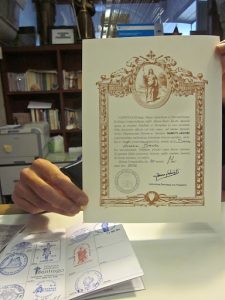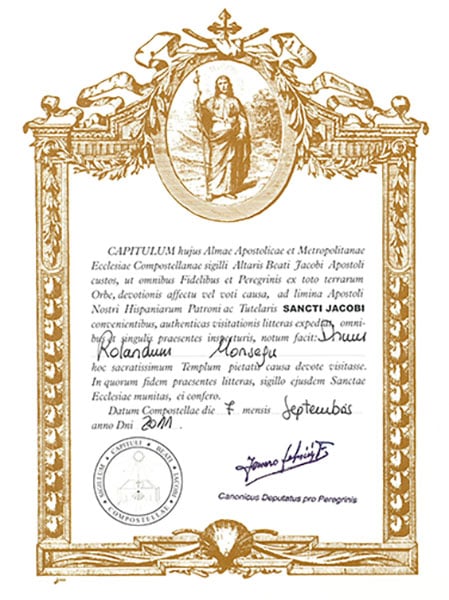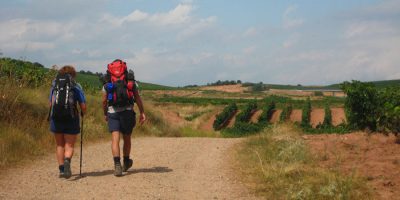What Is The Compostela Pilgrims Certificate?
The Camino de Santiago has always held great spiritual and cultural significance. Pilgrims wanted a way to recognise their completed journey. In the early days, the scallop shell became a symbol of arrival at the tomb of Saint James the Apostle. This symbolic gesture eventually evolved into the official Compostela Pilgrim Certificate (aka The Compostela).
Table of contents
- What Is The Compostela Pilgrims Certificate?
- The Problem with Scallop Shells
- The Creation of Evidence-Based Certificates
- The Historical Importance of the Compostela
- Changes in Pilgrimage and Growing Concerns
- Requirements for Receiving the Compostela
- To be awarded the Compostela:
- The Text of the Compostela Pilgrim Certificate
- Pilgrims’ Office Opening Hours
The Problem with Scallop Shells
Originally, pilgrims would pick up scallop shells to show they had reached Santiago de Compostela. It was a simple, honest tradition. However, this practice was quickly exploited. Vendors began selling shells to pilgrims before they had finished the route. This led to fraud, and the Church had to step in. Selling false signs of pilgrimage resulted in penalties, including excommunication.
The Creation of Evidence-Based Certificates
To protect the meaning of pilgrimage, a formal system was introduced in the 13th century. The Church started issuing documents called “Evidential Letters.” These proved a pilgrim had genuinely completed their journey. These documents are the direct predecessors of the Compostela Pilgrim Certificate (aka The Compostela) issued today.
The Historical Importance of the Compostela
The Compostela has long been an important and meaningful document for pilgrims completing their journey to Santiago. In the 16th century, the Catholic Monarchs established the Royal Hospital Foundation. They commissioned the construction of a hospital in Santiago specifically for pilgrims. This hospital occupied the building that is now the Hotel Hostal de los Reyes Católicos.
Pilgrims who presented their Compostela were permitted to stay in the hospital for three days. During their stay, the hospital provided medical care and support. It quickly became the most important medical facility in Galicia. Later, the hospital played a central role in the development of the University of Santiago de Compostela’s medical faculty. In 1954, the building was transformed into a state-run Parador hotel.
Despite this change, the spirit of hospitality lives on. Today, the hotel continues the tradition by offering free meals for three days to 10 pilgrims each day who present their Compostela.
Changes in Pilgrimage and Growing Concerns
In the 20th century, more pilgrims began arriving in Santiago by vehicle rather than on foot or bicycle.This shift led to concerns that the physical effort and personal sacrifice once essential to the pilgrimage were being lost. At the same time, various organisations began issuing certificates similar to the Compostela. These unofficial documents attempted to imitate the authenticity of the traditional Compostela, creating confusion and reducing its perceived value.
Requirements for Receiving the Compostela
To receive the Compostela, pilgrims must now provide proof of their journey using a credencial, or Camino Pilgrim Passport. The Cathedral of Santiago requires the following as evidence:
This rule has been in place for centuries and remains unchanged today. The credencial must be stamped along the way, at least twice per day during the final section.
Walking the Camino in Stages and Children’s Compostela
You may choose to walk the Camino de Santiago routes in stages. If you complete the last 100 km on foot or the last 200 km by bike in sections, you must collect a sello (stamp) with the date at the place you stop. When you resume, obtain another sello dated on the day you start again from the same location.
Children walking the Camino with their family or group can also receive a Compostela, provided they understand the pilgrimage’s religious and spiritual meaning. For more details, see our Camino for Families page.
If children are too young to qualify for the Compostela, a certificate with their name can be issued. For very young children, their names can be added to the Compostela of the accompanying adult. If you have any questions about this, please ask at the Pilgrims’ Office.

To be awarded the Compostela:
- You must have made the pilgrimage for religious reasons or a similar motivation, such as a vow.
- To arrive at the apostle’s tomb in the Cathedral of Santiago de Compostela, you must have walked or travelled on horseback for at least the last 100 km or cycled for the last 200 km.
- You should collect at least two Sellos (stamps) daily on your Camino Credencial Pilgrim Passport. These will usually be where you sleep and one other place, such as a Church, ayuntamiento, café, etc. You must ensure that you do this at least in the last 100 km from the Cathedral of Santiago if you are walking or on horseback and 200 km if you are travelling by bicycle.
The Text of the Compostela Pilgrim Certificate
The Compostela certificate (aka The Compostela) is traditionally written in Latin. The Pilgrims’ Office also records the pilgrim’s name in Latin. The translated text reads:
“The Chapter of this Holy Apostolic Metropolitan Cathedral of Saint James, keeper of the seal of Saint James’ Altar, to all faithful and pilgrims from around the world, who come as an act of devotion, vow, or promise to the Apostle’s Tomb, our Patron and Protector of Spain, hereby certifies that Mr/Mrs/Ms…………………has devoutly visited this Sacred Church for religious reasons (Pietatis causa).
In witness whereof, I present this document, authenticated with the seal of this Sacred Church.
Given at Saint James of Compostela on the (day) …… (month) …… A.D. …….”

Pilgrims’ Office Opening Hours
You can collect your Compostela at the Pilgrims’ Office in Santiago. Opening times depend on the season.
Summer Hours
From Easter Monday to 31 October:
- Open daily from 9:00 to 21:00
Winter Hours
From 1 November to Easter Sunday:
- Open daily from 10:00 to 20:00
- On Sundays and Camino festivals, the office closes from 14:00 to 16:00
The Pilgrims’ Office is open every day except:
- 25 December (Christmas Day)
- 1 January (New Year’s Day)
If you arrive on these dates, you can collect your Compostela inside the Cathedral. Read here to learn more about Camino Pilgrim Passports & Certificates. Don’t hesitate to contact us for more information on the pilgrim’s certificate (aka The Compostela) or any of the Camino de Santiago routes.



